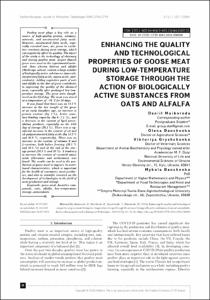Please use this identifier to cite or link to this item:
http://elar.tsatu.edu.ua/handle/123456789/17628Full metadata record
| DC Field | Value | Language |
|---|---|---|
| dc.contributor.author | Maiboroda, Daniil | - |
| dc.contributor.author | Майборода, Данііл Олександрович | - |
| dc.contributor.author | Danchenko, Olena | - |
| dc.contributor.author | Данченко, Олена Олександрівна | - |
| dc.contributor.author | Gryshchenko, V. | - |
| dc.contributor.author | Danchenko, Mykola | - |
| dc.contributor.author | Данченко, Микола Миколайович | - |
| dc.date.accessioned | 2024-05-29T15:40:09Z | - |
| dc.date.available | 2024-05-29T15:40:09Z | - |
| dc.date.issued | 2024 | - |
| dc.identifier.citation | Enhancing the quality and technological properties of goose meat during low-temperature storage through the action of biologically active substances from oats and alfalfa / Maiboroda D., Danchenko O., Gryshchenko V., Danchenko M. Eastern-European Journal of Enterprise Technologies. 2024, Vol. 1 № 11 (127). p. 20–28 | uk |
| dc.identifier.uri | http://elar.tsatu.edu.ua/handle/123456789/17628 | - |
| dc.description.abstract | Poultry meat plays a key role as a source of high-quality protein, vitamins, minerals, and unsaturated fatty acids. However, unsaturated fatty acids, espe cially essential ones, are prone to oxida tive reactions during meat storage, which can negatively affect its quality. The object of the study is the technology of obtaining and storing poultry meat. Legart Danish geese were used as the experimental mate rial. Oats (Avena Sativa) and alfalfa (Medicago sativa) contain a large number of biologically active substances (minerals, unsaturated fatty acids, amino acids, anti oxidants). Adding vegetative parts of oats and alfalfa to the diet of geese contributes to improving the quality of the obtained meat, especially after prolonged low-tem perature storage. The geese were slaugh tered on the 63rd day. The meat was stored at a temperature of –18 °C for 90 days. It was found that there was an 11.5 % increase in the live weight of the geese at an early slaughter age, an increase in protein content (by 5 %), better mois ture-binding capacity (by 6–7.3 %), and a decrease in the content of lipid perox idation products, especially on the 67th day of storage (28.3 %). There was a sig nificant increase in the content of ω3 and ω6 polyunsaturated fatty acids (by 24.2 % and 10.8 %, respectively). There was an increase in the content of vitamin E and β-carotene, both before freezing (38.5 % and 19.6 %) and at the end of the stor age period (50.9 % and 20 %). A tendency to increase the content of essential amino acids (threonine and methionine) was found. The results can be used in the pro duction of goose meat to improve its nutri tional characteristics, which is important for the health of consumers, meat produc ers, and also in scientific research on the development of technologies in the field of meat production and storage. | uk |
| dc.language.iso | en | uk |
| dc.subject | goose meat | uk |
| dc.subject | bioactive com pounds | uk |
| dc.subject | oats | uk |
| dc.subject | alfalfa | uk |
| dc.subject | low-temperature storage | uk |
| dc.subject | antioxidants | uk |
| dc.title | Enhancing the quality and technological properties of goose meat during low-temperature storage through the action of biologically active substances from oats and alfalfa . | uk |
| dc.type | Article | uk |
| local.identifier.doi | 10.15587/1729-4061.2024.296900 | uk |
| local.identifier.udc | [577.1+637.04+636.5+633.13]:664.8.037.53 | uk |
| Appears in Collections: | Кафедра Харчові технологіі та готельно-ресторанна справа | |
Files in This Item:
| File | Description | Size | Format | |
|---|---|---|---|---|
| Enhancing the quality_2024.pdf | 814.69 kB | Adobe PDF |  View/Open |
Show simple item record
CORE Recommender
???jsp.display-item.check???
Items in DSpace are protected by copyright, with all rights reserved, unless otherwise indicated.
